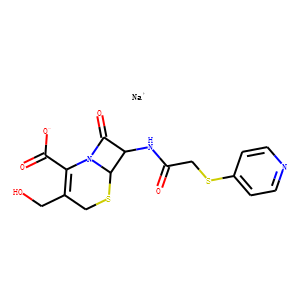| Reference | [1]. J Chromatogr. 1986 Jun 27;361:285-90. doi: 10.1016/s0021-9673(01)86917-x.<br />
Stability-indicating liquid chromatographic determination of cephapirin, desacetyl cephapirin and cephapirin lactone in sodium cephapirin bulk and injectable formulations.<br />
MacNeil L, Rice JJ, Muhammad N, Lauback RG.<br />
A specific, stability-indicating, high-performance liquid chromatographic assay was developed for the determination of cephapirin, desacetyl cephapirin and cephapirin lactone in sodium cephapirin (cefadyl) bulk and injectables. The procedure uses a muBondapak C18 column and a mobile phase of dimethylformamide-acetic acid-potassium hydroxide in water. UV detection at 254 nm is used for quantitation with acetanilide used as the internal standard. The assay is precise, accurate and linear over the range of 100-300 micrograms/ml for cephapirin and over the range of 2-6 micrograms/ml for desacetyl cephapirin and cephapirin lactone. The assay is also stability-indicating for the described thermal, acid, base, aqueous and accelerated light degradations.<br />
DOI: 10.1016/s0021-9673(01)86917-x PMID: 3733955 [Indexed for MEDLINE]<br />
<br />
[2]. Diagn Microbiol Infect Dis. 1984 Jan;2(1):65-8. doi: 10.1016/0732-8893(84)90024-5.<br />
Cefotaxime, cephalothin, and cephapirin: antimicrobial activity and synergy studies of cephalosporins with significant in vivo desacetyl metabolite concentrations.<br />
Jones RN, Packer RR.<br />
The desacetyl metabolites of cefotaxime, cephalothin, and cephapirin were 5-55% as active as the parent drug, depending upon the bacterial species tested. Synergy or partial synergy was demonstrated in 64% of 25 strains of Enterobacteriaceae and Staphylococcus aureus tested against cephalothin/desacetylcephalothin and cephapirin/desacetylcephapirin combinations. Some species variations were identified that influenced synergy rates, particularly among the S. aureus strains (for example, highest rates for cephapirin).<br />
DOI: 10.1016/0732-8893(84)90024-5 PMID: 6100364 [Indexed for MEDLINE]<br />
<br />
[3]. Jpn J Antibiot. 1975 Aug;28(4):542-8.<br />
Comparison of absorption and excretion of cefazolin with cephalothin and cephapirin.<br />
Shimizu T.<br />
Since the discovery of cephalothin in 1962, many semi-synthetic cephalosporins have appeared. To choose the most suitable drug for the clinical treatment of infections, the characteristics of these antibiotics must be sufficiently understood. When cephalosporins which are or will be commercially available are divided into two categories, one consists of cephaloridine, cefazolin and cephalexin which are comparatively stable in the living body; and the other cephalothin, cephaloglycin, cephapirin and cephacetrile which are metabolized into desacetyl compounds with low antibacterial activity. In this study, the author compared the absorption, excretion and some other properties of cefazolin and cephalothin, (widely used clinically), and cephapirin (still under study in Japan).<br />
PMID: 1160145 [Indexed for MEDLINE]<br />
<br />
[4]. J Dairy Sci. 2013 Jul;96(7):4455-64. doi: 10.3168/jds.2012-6487. Epub 2013 May 16.<br />
Elimination kinetics of cephapirin sodium in milk after an 8-day extended therapy program of daily intramammary infusion in healthy lactating Holstein-Friesian cows.<br />
Gorden PJ(1), van der List M, Lehman FD, Lantz RK, Constable PD.<br />
Author information: (1)Department of Veterinary Diagnostic and Production Animal Medicine, Iowa State University, Ames, Iowa 50011-1250, USA.<br />
The objective of this study was to determine the elimination kinetics of extended therapy with intramammary (IMM) cephapirin in lactating dairy cattle. Eight healthy Holstein-Friesian cows were administered cephapirin (200mg) into all 4 mammary glands every 24 h after milking. Cows were milked 3 times per day and concentrations of cephapirin and desacetyl cephapirin were determined in bucket milk using liquid chromatography-mass spectrometry. Milk concentration-time data after the last of the 8 IMM infusions were fitted using compartment and noncompartmental models. The maximum cephapirin concentration was 128±57 µg/mL (mean ± SD), the elimination rate constant from the central compartment was 0.278±0.046 (h(-1)), clearance was 0.053±0.023 L/h, the half time for elimination was 2.55±0.40 h, and the mean residence time was 2.65±0.79 h. The cephapirin concentration was below the approved tolerance in all cows by 96 h after the last infusion, which is the labeled withholding time for the preparation used. Extended therapy for 8 d provided milk cephapirin concentrations above the minimum inhibitory concentration for common gram-positive mastitis pathogens (0.1 to 1.0 µg/mL) for the duration of therapy and for an additional 16 to 32 h after the end of treatment. Our findings suggest that this IMM cephapirin sodium formulation, which is labeled for 2 doses 12 h apart, could be administered at a 24-h interval for up to 8 d in cows milked 3 times per day, with no significant effect on residue levels by 96 h after the last treatment. Longer withdrawal times would be prudent for cows with low milk production.<br />
DOI: 10.3168/jds.2012-6487 PMID: 23684021 [Indexed for MEDLINE]
|

